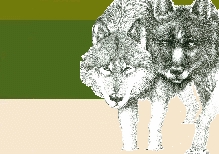|
|
 |
Wolves Benefit Deer herds
by Joseph S. Butera
Predators play a critical role in the well being of our global environment. in fact, life on earth would cease to exist without them. We have learned much about predatory patterns since the wolf has been restored to Yellowstone National Park and the midwestern states including Minnesota, Wisconsin and Upper Michigan. Our knowledge of these majestic and fascinating animals has enriched our understanding of the dynamic relationship between wolves, other predators and the influence they have on their prey species.
Scientific data show that wolves have far less negative impact on the deer population than do coyotes, which are common in the Adirondacks. In fact, when wolves are present, coyote populations decrease. On average 10 wolves will displace 100 coyotes in a given 100 square mile radius. The average weight of a coyote in the adirondacks is 40 pounds. The average wolf’s weight in Southeastern Canada is 90 pounds. If we calculate the weight of the animals against the number of animals in a given area we will come up with the weight of biomass needed to sustain the health of either species in the region. The biomass is the number of pounds of meat needed to sustain a healthy group of animals for a given year. the meat removed from the ecosystem is hypothesized to be deer, beaver, rabbit, rodents and other prey. The chart below represents the effects on the biomass when 10 wolves displace 100 coyotes in any given area:
Number of Animals x Average Weight Per Animals = Required Biomass
100 Coyotes x 40 lbs = 4000 lbs
10 Wolves x 90 lbs = 900 lbs
These calculations show that coyotes consume far more prey in a given area than wolves. This is the current data being formulated by researchers in the field where wolves have either been reintroduced (Yellowstone National Park and Idaho), or where their numbers have increased naturally (Wisconsin, Minnesota and Upper Michigan). In each of these areas, the wolf’s return was followed by a dramatic shift in the ecosystem’s biomass and the observable changes in the flora and fauna.
Coyotes themselves are not the villains in this picture. When coyotes become overpopulated in an area the ecosystem becomes imbalanced. The best way to correct that imbalance is to work within the laws of nature. Hunting coyotes only leads to more coyotes unless one destroys up to 70% of the population. State and federal funds needed to control coyote populations would be astronomical, not to mention the political ramifications and the amount of man-hours required to manage such a policy. Anything less than a nationwide effort would be futile. Coyotes from neighboring states would re-colonize the vacant forestland. Wolves effectively reduce coyote populations and they do this job free of charge.
When coyotes are persecuted, either by hunting and/or trapping, their numbers increase because females coyotes will go into estrus twice a year, rather than once, and litter size will increase. the end result is more coyotes. This is not the case with wolves. Pack size for wolves is determined by food supply and by mating practices. The alpha male and female are the only pair that mate within the pack, producing one litter per year. If the unit is lucky, perhaps 2 or 3 offspring will survive to adulthood.
Wolf restoration has dramatically improved Yellowstone’s ecosystem. Aspen trees are once again flourishing. Before, elk had heavily browsed the river valleys where the trees grow. Since the wolf’s return, the elk have retreated to higher ground that affords better cover. Both elk and bison populations are healthier and stronger, and the number of coyotes has decreased. Wisconsin also has seen positive results since the wolf’s expansion in recent years. An epidemic of chronic wasting disease in Wisconsin has thinned deer herds in much of the state, but in the north, where wolves prey on deer, the disease has not taken hold and the herds remain vigorous. Resulting in stronger, healthier deer. The state’s trout streams in wisconsin have also benefited: since wolves also prey on beaver, there are fewer beaver to build dams that turn streams into ponds. This has preserved the environment in which trout thrive.
A review of the hunting records for Wisconsin, upper Michigan and Minnesota indicates that as the wolf population increased, there has been no negative effect on the sportsmen’s deer harvest. For example, hunters killed 184,000 does and 215,000 bucks in Wisconsin in 1990, when the state contained only about 40 wolves. In 2001, when the state had about 250 wolves, the state’s hunters killed 314,000 does and 272,000 bucks. Overall, that represents a 47% increase in the deer harvest.
The wolf is considered a cornerstone species buy many ecologists, in that it has positive affects on a whole array of ecosystems. If the wolf were to return to the Adirondacks, the natural balance of wildlife would be restored: beaver and coyote populations would decline while the deer population would most likely increase. Fewer beavers would mean less destruction of timberland and less flooding of streams. Since wolves tend to take the sick, the old and the less fit, their presence would lead to stronger, healthier moose and deer herds. If chronic wasting disease does enter the Adirondacks, wolves would slow its spread by culling out the diseased deer. Likewise, a brain worm that is transmitted from deer to moose would be less likely to become epidemic, thus boosting the survival rate of the moose, which is returning to the park on its own.
The Native Americans hunted side by side with the wolf, and as far as we can tell the wolf never depleted the food resource. The Native Americans had a saying. "It is the caribou which feeds the wolf…but it is the wolf, which keeps the caribou strong". |
 |



![]() copyright © 2005 Northeast Ecological Recovery Society, INC. all rights reserved.
copyright © 2005 Northeast Ecological Recovery Society, INC. all rights reserved.